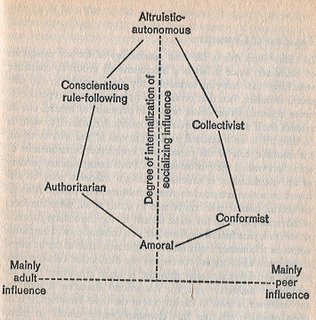Personality: Another stab
 Still cognitating about personality because it is important to what I want to write. Today, stroking the one cat I have left, a jumpy, affection-seeking Tonkinese, I listed to her, like a Buddhist mantra, the names of all the past felixes I have known: she knew the last one. The fact that they were so distinct, had clearly remarkable personalities, made me think of the business of the blackbirds: research has shown they were not black to other blackbirds. Because their eyes picked up different wavelengths of light outside our range, blackbirds appeared subtly coloured to other blackbirds.
Still cognitating about personality because it is important to what I want to write. Today, stroking the one cat I have left, a jumpy, affection-seeking Tonkinese, I listed to her, like a Buddhist mantra, the names of all the past felixes I have known: she knew the last one. The fact that they were so distinct, had clearly remarkable personalities, made me think of the business of the blackbirds: research has shown they were not black to other blackbirds. Because their eyes picked up different wavelengths of light outside our range, blackbirds appeared subtly coloured to other blackbirds.
Sure we see the distinct personalities of our cats in different way to the way cats see them. But the point is we sort of assume we remember the distinctness - a thing which helps to keep them popping back into our minds, like other special things such as people, places, sounds smells, writing, or music, or art - as if a generality, when it in fact it is highly specific: it is how I saw a favourite dead cat. Right at that special moment or recolection, a special set of neural circuits fires, which is like no other set of circuits. And, if we fail to remember, those circuits will fade.
In the end its all and always about the receiver not the sender of messages. Chinese whispers of the human soul.
::
In chatting to a friend across the world yesterday, I explained about my son's dyslexia, saying it was possible with no understanding of the details of how the brain works to set out the elements of the problem, and in a way to understand what was wrong. As we were talking I proceeded to construct the diagram, telling him in stages, as I re-remembered old doodles, sketching anew on a scap of paper, just how it worked and what ir showed.
He happened to be a software engineer, so quickly latched on to my symbols S(speaking), R (reading), L(listening), W(writing), instructing me to put subscript Is and Os on each letter, for input and output. Knowing I was talking to someone who had done thousands of flow-charts and engaged in the same sort of flow-charting/algorithmic thinking a thousand times, I then said you can draw lines connecting all four processes. But then I said something else: that you have to place the whole lot in a circle labelled memory. It was about association and recall.
There are many diagrams like this in the dyslexia literature. I knew how to draw a simple one because I knew what a dyslexic could and could not do from hours of observation! Forgetting, it was easy to reconstitute the basic problem in the form of a diagram, visualising the elements one by one. SEE: SAY, WRITE ; HEAR: SAY,WRITE. What this shows is an association problem, between object -> image -> sound, though some experts go on about retention and recall and even IQ.
One researcher beleives fro the dyslexic sounds travel too fast (they retain meaning better when it is said or read slower with more space between the words). But that's just the hearing section. The other, seeing, has others experts suggesting word size and more space between words can help. One guy invented software which colour coded words on the wordprocessor page, but I never got to see it.
::
As a child grows it learns to put a name to an object.Then it learns to put a picture and then word shape to the association. It learns letter shapes, then phonetics, then it learns to fluently read and say what it is reading, and write down what it is thinking with amazingly few errors of spelling or syntax.
Though many dyslexics grow up to be successful people, as architects, designers, scientists, they are so clearly (from a non-dyslexics eyes) seeing the world and being able to manipulate it in such a different way from good readers (as in reading silently and out loud) it makes me think of a distinct sub-species as the various autists seem to me to be.
Yeats: 'sick with desire and fastened to a dying animal'
Sailing to Byzantium {
1 } {
2 }
Eighteenth Century England:
A site created by and forLiterature student of the University of Michigan
SHOWCASE growabrain
Grow-a-brain
This is the 'books and literature' page of this compendiblog. There's everything there as can be seen from the blogroll. He's got generic cinema and a set of more specific ones, such as cinema - The Godfather.
Rooted from his profile that he wrote, maybe even continues to write, poetry in Hebew: Between Geography & Mescaline
which tells you a bit. Wish I ould read Hebrew. You need to learn at least three languages from as early as you can, I think. Most of our early education could be scrapped in favour of language training. If people are popping round the world nowadays, how can they grasp other cultures with being able to speak the languages they were formed in? I am trying Spanish but it is a slog grinding away the vocab.
There are sorts of links of interest in grow-a-brain, many of which you can miss but come across another time. He uses his weblog to attract people to his main site which is his real estate business.
A Gentle circumspection ?
Bipolar Guy's latest post pretty much covers it for the blog community. There is way, which I have tried to adopt, to treat a blog as a kind of commonplace book rather than diary. Hence Moleskine Modality: an expensive notebook to check your wilder excesses.Many find essays the way round it. No one who writes wants to give all their ideas away. Some are obviously not unique: it is the very necessity to choose which decided what is what: I might have kept the character typology diagram, below,to myself, but having someone to say they find it useful outweighs the desire to keep mum! Think of a conversation you have with a stranger in a supermarket. You bump into her trolly. The dual apology echoes. You smile and make a lame joke about driving licences and sides of the road. She does not smile but responds with a few well chosen phrases before moving on. A gentle circumspection, not a complete brain exchange.
Podcasting on odeo.com
 Interweb radio has been a large part of my broadbandified experience because I can listen as well as write. The BBC has been a favourite since it is so good on the talk side, but there are myriad others. U.S. stations can be very good on science talks.
Interweb radio has been a large part of my broadbandified experience because I can listen as well as write. The BBC has been a favourite since it is so good on the talk side, but there are myriad others. U.S. stations can be very good on science talks.
You'd have to be blind not to notice the number of sites which have the technouse to incorporate podding into their posts. Though I've avoided it like the plague because it is easy to spend half a day on something like this, just to understand what it is about and the basics of how to include one.Through the good services of the Telegraph blogs today came across odeoIt seems only right to share it with my fellow readers and writers. Note at this page in odeo there is a side list of various categories currently available. Of course, anything you record and link to your site is also generally avaible through the odeo page itself. It can only bring more traffic to your blog. Those of you who do really good reviews will I feel sure be keen to adopt this technology. I hope you will, because listening to a review while doing something else at the same time seems like the essence of ICT. ::
My dream has been of a very high-tech, shiny metal, smoothly articulated armature fixed above the bedhead which allowed me to type into the upsidedown laptop from the pillow while listening to the world service, with the added advantage of being able to push the computer up and out of the way with a gentle sweep of the arm in the moments just before sleep intervenes.
Word of the day - metastasizing
Telegraph, 18 April 2006Meanwhile Dan Gillerman, an Israeli Ambassador the UN, told a Security Council debate that Hamas leaders were inciting acts of terrorism.
A dark cloud is looming above our region, and it is metastasizing as a result of the statements and actions by leaders of Iran, Syria, and the newly elected government of the Palestinian Authority," Mr Gillerman said.
intr.v. me·tas·ta·sized, me·tas·ta·siz·ing, me·tas·ta·siz·es - To be transmitted or transferred by metastasis.
- To be changed or transformed, especially dangerously: “a need for love that would metastasize into an insatiable craving for attention” (Michiko Kakutani).
- To spread, especially destructively: “ [disinformation]... that even now continues to metastasize... to such a degree that myth threatens to overthrow history” (Gore Vidal).
reference.com
Is a theory like a design?

 Clearing up some loose ends on verisimiltude led as a previous post shows, to Popper's Objective Knowledge, and questions of theory.Using a borrowed kettle for a few days while getting around to buying a new one, two and two added up to three - or five - and there was a set of what I thought might be analogies between Theory and Design. This came from a desire to have a simple fool-proof way of explaining what a theory was using a much simpler idea.I guess its not right at all, but the desire to describe what arrived is greater than the desire not to be publicly ridiculed. In essence, I haven't a clue what I am suggesting but would be grateful for some feedback.Theory = > EvidenceDesign = > Object (implementation)As soon as I used the kettle for the first time, I realised, though it is good looking, it was a poor design in practice. (1) the spout was too small, in the wrong place, and would not pour properly. (2) The relationship of the handle to the spout made it hard to pour: the ergondynamics all wrong.
Clearing up some loose ends on verisimiltude led as a previous post shows, to Popper's Objective Knowledge, and questions of theory.Using a borrowed kettle for a few days while getting around to buying a new one, two and two added up to three - or five - and there was a set of what I thought might be analogies between Theory and Design. This came from a desire to have a simple fool-proof way of explaining what a theory was using a much simpler idea.I guess its not right at all, but the desire to describe what arrived is greater than the desire not to be publicly ridiculed. In essence, I haven't a clue what I am suggesting but would be grateful for some feedback.Theory = > EvidenceDesign = > Object (implementation)As soon as I used the kettle for the first time, I realised, though it is good looking, it was a poor design in practice. (1) the spout was too small, in the wrong place, and would not pour properly. (2) The relationship of the handle to the spout made it hard to pour: the ergondynamics all wrong.
Looking around the room for a good pourer - the classic tea pot - to compare with the design and functionality of the glass kettle, I saw by picking up the tea pot how easy it was to pour, with no strain on the arm.
The glass kettle is a beautifully designed object, but the functions are subsumed to its looks. Overall, it is a failed design because it is an aesthetic rather than a functional item. It just doesn't work as a kettle, in the water pouring sense, even though it heats water perfectly well.
At this point I oought to add that I have been doing a little reading: theory described as a set of sub-hypotheses fits quite well with the objectives any design. (all coloured writing has been added the next day)
Design is not a strict analogue of theory. Though in practice the way a design succeeds is similar to the way a theory does and is a way of explaining in simple, concrete terms (a) what a theory is [the wiki entry deals with the etymology of the word and one of the original meaning s of thw word in Greek theatre], (b) how it achieves virisimilitude.
There are elements of the concept of theory in the concept of design. The Classic tea pot is a very good pourer and looks good. Whatever went into the design (the principles that apply for pouring devices such as kettles and tea pots) will always give good pouring and and allow the arm to work efficiently without strain on muscles, tendons and ligaments). Of course, we are talking Kettles and tea-pots a bit like The Mad Hatter's Tea Party, but go with the flow.
A failed design is like a failed theory.
Here parts may be true because the hypotheses are sufficient to the task/ some but not all the design elements work in practice.
Plenty of people will have this type of kettle and be wondering why I think it won't pour. The answer is simple: it is pefectly good at pouring from full or half-full, but a cup or two, for a cup or two, is where the design falls apart. The reason this has come about can only be explained from the designer's-eye point of view. The kettle can't have been mass produced without a thoroughly check of its pouring ability. So the only conclusion for the cup or two, is no one tried to pour with only a few hundred c.c.s in the bottom of the kettle before the decision was made to o.k. the design. If they had they would have experienced the problems described. So, in other words this is a full-type kettle, not a generic pour kettle.
The same goes for a theory: most important, when devising one, to make sure the equivalent of the 'quarter-full kettle pouring problem' is avoided! It highlights the need for experiments beforehand.
Wiki: theory
In scientific usage, a theory does not mean an unsubstantiated guess or hunch, as it often does in other contexts. A theory is a logically self-consistent model or framework for describing the behavior of a related set of natural or social phenomena, which originates from and/or is supported by experimental evidence
A design is based on prior knowledge too, though more and more designs seem as if they are not. This may be explained partly by the design techniques used. I once saw on TV a telephone designed on computer, the designs sent to a factory in Asia and the samples in different colours made within days. No one seemed to be trying them out in various ways to see if they worked in such simple features as where the wires attached to the base and how easy the handset fell off. Later I bought one very much the same and have never been able to keep the phone flat on the table because of the wires and the hand set falls off its cradle very easily. Thousands of phone designers before recognised a wire attached to the side or back was the simplest way, but the more modern flatter profile requires (for some reason to do with electronics probably) otherwise.
Its over to you. Is a theory like a design?
P.S.
Theories have assumptions built into them: the glass kettle designer assumed everyone would fill it up, and not be water conservation-minded.
Cesare Pavese
Someone gave me a pile of Saga magazines - I must look older than I imagine.Dear Diary, August 2005, compiled by Alan and Irene Taylor:Cesare Pavese, August 3 1937A woman unless she is an idiot, sooner or later meets a piece of human wreckage and tries to rescue him. She sometimes succeeds. But a woman, unless she is an idiot, sooner or later finds a sane, healthy man and makes a wreck of him. She always succeeds.
Chuckling but being caught between a desire to pass it on and PC, decided to compromise by finding another Pavese quote:Literature is a defense against the attacks of life. It says to life: "You can't deceive me. I know your habits, foresee and enjoy watching all your reactions, and steal your secret by involving you in cunning obstructions that halt your normal flow.
Alastair Gray
There is fine balence to be had between checking around for the new and interesting and getting on with something. It is very easy to be unlucky, spending an hour linking here, linking there, linking everywhere, to find not a jot of substance. Yesterdays trawl pleasingly brought up Gray's blog, which I had no idea existed. I like reading about writer's lives: a fault tantamount to a crime against humanity , in the eyes of the uberliterati, it seems.
Rolled Jeanette Winterson under category 'profession writer's blogs', a few months ago, to see how much she gave away: not much. Cards pretty close to chest and promos.Intriguing to see an unfinished one act play, Goodbye Jimmy, in a 15 March post, wondering if he hopes someone is going to finish it for him. We know they will, whether this was his intention or not.
There is an unofficial Alastair gray website, Lanark 1982
Barenboim
I realise I have made a fundamental error in using Daniele's Rule as my lietmotiv. It should have become Daniele's Modified Rule :A man who wants to read, write, listen, talk, and so on and so forth, must let the grass grow long.
Daniele's Rule came from the section Profound Principles for the Profound in1001 logical laws, Accurate Axioms, Profound Principles, Trusty Truisms, Homely Homilies, Colourful Corollaries, Quotable Quotes and Rambunctious Ruminations for all walks of life.
compiled by John Peers (Fawcett Gold medal, 1978) ISBN 0449134148which also included Mark Twain's PostulateAlways do right. This will gratify some people, and astonish the rest
...Popper, in his significant work Objective Knowledge, explains his idea of versimilitude by reference to the concept of theory. He defines truth content and then uses as examples the theories of gravitation of Newton and Einstein. One of the key reasons that E is superior to N, he reasons, is that
...it offers us new opportunities to learn more about the facts: without the challenge of Einstein's theory, we should never have measured (with the greater degree of precision needed) the apparent distance between the stars surrounding the sun during an eclipse, or the red shift of the light emitted by red dwarfs'.
...the stronger theory, the theory with the greater content, will also be the one with the greater virisimilitude unless its falsity content is greater.
After listening to Daniele Barenboim's first Reith Lecture, I had the same sort of feeling about verisimilitude and theories, even though he wasn't specifically posing another theory against his. He was making claims for music through his knowledge of it and by using analogies with real life events, which made it particularly interesting. For example, he argued that engaging in music was a training for democracy, placing before us the analogues of each sphere, music and politics (or life if you wish). At the end, during questioning, he exhorted for music at an early age, which no one who had understood what he was arguing could deny.If you haven't listened to it the web page from which it all starts is here.
There is a transcript of the first lecture on the page too, which includes the Q & A which was as long as the lecture itself.P.S.9 AprilA wag suggested the first lecture was so thin DB must have jotted it down on a scrap of paper in the way up in the lift, but as soon as I got into the talk, it seemed clear to me that the simpler the beginning the more effective the follow-through. Though waiting the right moment for no. 2 (requisite attentiveness, silence and calm) gleaned from elsewhere that he was said to have become slightly unhinged during a section where he decried musak (in lifts presumably), then in number 3 apologised for going on a bit. I checked the transcript of no. 1, to enjoy a joke when asked by a neuroscientist who had expalined his research scanning musicians brains and finding the the emotional centred did not light up. PROFESSOR PARSONS:
Hi, I'm er Professor Lloyd Parsons, and I, I'm a brain scientist, and what we do is we put musicians in brain scanners and monitor the blood flow in the brain while they perform on an electric piano for example - or singers in other cases - but on an electric piano. And two of the things we noticed are that the brain areas that would normally be excited and represent the emotional responses to music are not active for the musicians who's performing, relative to playing scales for example. And we also noticed that large other regions of the brain are also de-activated, they're not engaged, and those are regions that allow you to plan the future, to think about what's going on in the environment, and for salient events. So my two findings about brains of musicians who are performing suggests that the performance of the music allows us to get to some sort of inner peaceful place in which our emotional worries and our attention to the world are detached. And you refer to this, as many of us do, as heart and brain, but as a brain scientist it all happens in the brain.
SUE LAWLEY:
You didn't say what… you didn't say what sort of music you were playing to this.....
PROFESSOR PARSONS:
This was Bach.
SUE LAWLEY:
Bach? Okay.
PROFESSOR PARSONS:
Bach. So one thing I might ask you is whether your own intuitions, as you play The Well Tempered Klavier for example, fit this scientific view of what's happening in the brain of a musician like yourself.
DANIEL BARENBOIM:
You know I won't be able to play tomorrow!
Reverse engineering Proust's madeleine
The Way the Cookie CrumblesHow much did Proust know about madeleines?
Edmund Levin, Slate, 11 May 2005
(via Amadeep Singh)
And, here the necessity to have a diagram of the cake.
To read War and Peace you don't need diagrams
 Perhaps the best kind of posts are those which you are not exactly sure why you are writing and what they are going to be about. With this in mind, I add at this point: this is not pre-prepared but going straight into the post. The main reason:to get it over quickly. I am timing myself and plan to get this over in 15 minutes. I have other fish to fry.Most people trying writing fiction will have come across the business of character. I am not alone, surely, in having to revise what this was all about, only to end up as I have done in a sideshow - albeit a rather interesting one - that of character in the sense of personality.
Perhaps the best kind of posts are those which you are not exactly sure why you are writing and what they are going to be about. With this in mind, I add at this point: this is not pre-prepared but going straight into the post. The main reason:to get it over quickly. I am timing myself and plan to get this over in 15 minutes. I have other fish to fry.Most people trying writing fiction will have come across the business of character. I am not alone, surely, in having to revise what this was all about, only to end up as I have done in a sideshow - albeit a rather interesting one - that of character in the sense of personality.
This diagram comes from Dererek Wright's The Psychology of Moral Behaviour. Titled 'the character typology', it shows the - yes - types of character. Clearly, this does not mean anyone fits into any one of these categories and not into any of the others. Or, indeed, that they are really distinct types: its a bit theoretical but based on much study of what humans are like.Lack of diagrams in adult fiction: there have always been frontispieces and maps (I came across a website dedicated to all the maps in Denis Wheatley novels a few weeks ago) but have you ever seen a map or diagram or hand sketch in what they term serious fiction? Someone reading War and Peace doesn't need a diagram.
Courses in creative writing give the same sorts of advice on plotting, setting, character, and so on, but it is pretty much up to the apirant to provide the motivation to setting his words down on paper and keeping them coming. Many can't stop writing them down. I am of the type who writes a bit then goes away to study something (some essential facts or as in this case some things to do with personality over character). In the process the impetus is slowed but a feeling that one is getting deeper into what one is engaged in, compensates. There is often a satisfying feeling, a bit like watching the rain drip down windows on winter days from the warm dry side, that the journey is more important that arriving. The few pages written down really quickly are then overpowered by a charge into a variety of books - other fiction, technical books, almost random surfing. This can be frustrating, especially when later you realise if you had resisted the urge to look something up you might have written the customary 2000-3000 words.
Some writers will say how the ideas come: there is a surge, it is dissipated, then its on to something else. The thing doesn't stop (it can't, you will not stop thinking about it consciously or unconsciously) but the day is usually taken up with other things, with the hope, having slept on it, there is further flurry of creativity.
Many writers will draw diagrams (charts, Venns) to help them through the maze of what they writing, either right from the start or part way through, but how many need - yes really need - pictures which they can refer to when they need to overcome the urge to stop writing or begin wondering what it is they think they are writing about and why? Though sandwiched between the spaces on the diagram I have here, there are whole libraries of other words, written by all sorts, this as it is is the one which is going to help me a lot. I may explain a bit more later, or maybe I'll leave it at that. I can say having files of graphics I find very helpful. Just to be able to flick through an assortment of randomly arranged photographs, cuttings from colour magazines, photocopies of favoured paintings, or my own sketches of something ot other can do something to alter my state of mind in the required direction. It doesn't always work. One picture alone, say a a painting of light shining betweening an avenue of trees, can set my mind and emotions off along exactly the wrong course and spoilt everything.
I don't mind sharing this diagram: perhaps I'm altrusitic/autonomous? Hopefully it can be useful to someone else apart from students of psychology.
6 April 2006 Found this page: Psychological Types (after the Jung & briggs-Myers typology)
which is quite good fun with its coloured diagrams.
Site Feed





